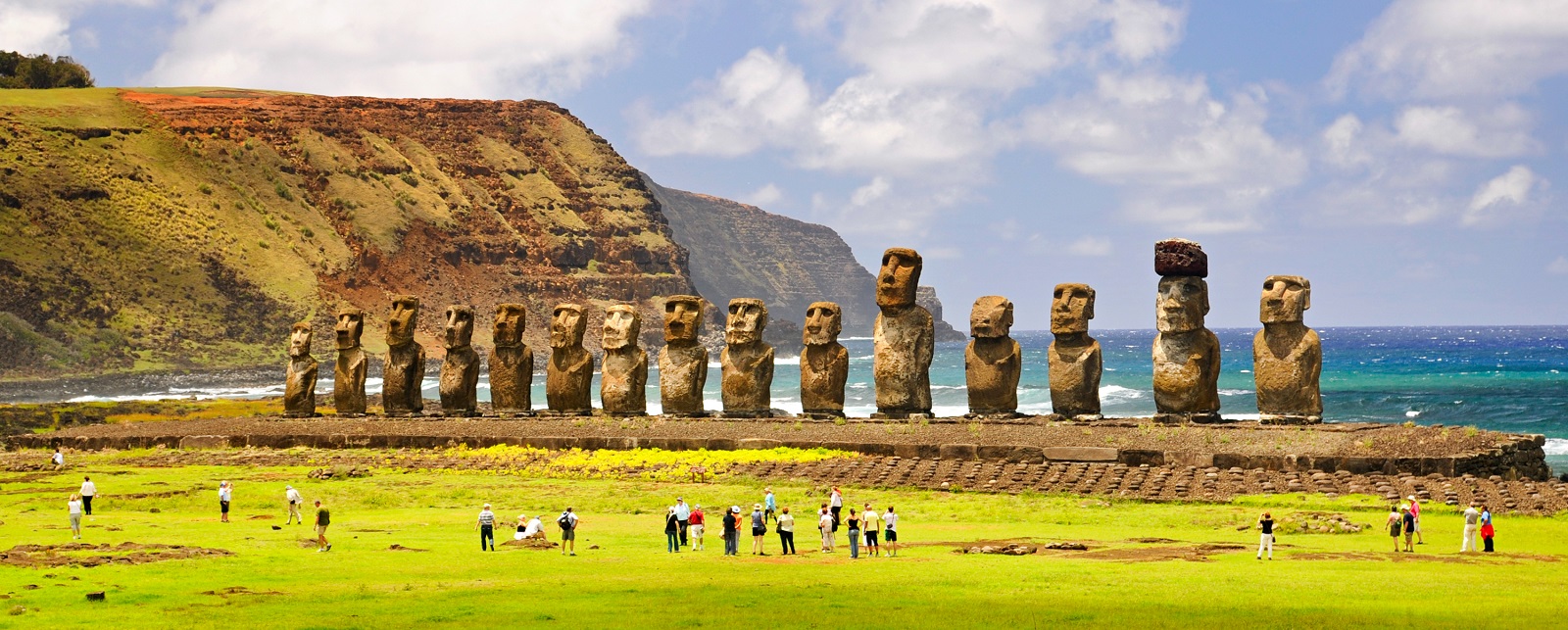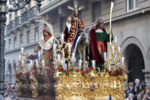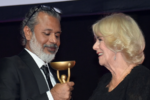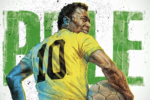“EYES LOOKING TO THE SKY”

Although Easter Island, located in the mid-Pacific Ocean, in Eastern Polynesia, is one of the loneliest and the most isolated spots on earth, the Rapa Nui, as its inhabitants are called, have carved impressive human figures from volcanic ash. What was the motive behind embarking upon such a massive statue-building project? How did a civilisation evolve on such a remote island? What were the reasons that caused its destruction? The solemn faces of the stone giants of Easter Island keep on looking up into the sky, perhaps inviting scholars to unravel their mystery.
The tiny Easter Island, a special territory of Chile since 2007, covering an area of 163.6 km² and separated from the rest of the Polynesian chain by the ocean water, is surrounded by three volcanoes that give the island a triangular shape. Although the island is full of volcanic soil, it is a picturesque place with surging breakers, precipitous cliffs, towering volcanoes and open, windswept slopes. But, what attracts the visitor most, are the island’s iconic giant stone statues with their brooding eyes staring into the far-off sky over a barren landscape, facing away from the ocean.
The statues or moai, meaning “statue” in Rapa Nui language, are carved out of buff-coloured volcanic stone called moai. The average height of the moai is about 4 m, usually weighing around 13 tons. The tallest of some 900 such statues erected, stood almost 10 m and weighed 82 tons. The heaviest moai was shorter, but weighed 86 tons. One unfinished sculpture, if completed, would have been nearly 21 m tall with a weight of about 145-165 tons.
A notable research on the statues was done in 1914-15 by Katherine Maria Routledge (1866-1935), an English archaeologist and anthropologist. She described the island as a place where the past is the present and where the shadows of the departed builders still possess the land. Other researchers include the American W. J. Thomson (1886); Alfred Métraux (1902-1963), Swiss and Argentine ethnologist; Henri Alfred Lavachery (1885-1972), a Belgian who was the first professional archaeologist to visit the island; Fr. Sebastian Englert (1888-1969), a German Franciscan missionary and linguist, known for his pioneering work on Easter Island in 1935-39, where a museum is named after him; Thor Heyerdahl (1914-2002), the famous Norwegian adventurer and ethnographer (1955-56); and American anthropologist William Thomas Mulloy (1917-1978). Due to the painstaking efforts of these scholars many toppled statues in the late 18th and early 19th centuries, possibly resulting from European contact or internecine tribal wars, were restored to their original positions.

Who built the statues and what did they signify?
The inevitable question as to who carved such magnificent statues has given rise to many surmises. Some scholars have disclosed amazingly interesting stories, saying that Easter Island was the Lost Continent. Others opined that it could have been inhabited by beings from outer space or the islanders were direct descendants from ancient Egyptians. However, modern researchers are unanimous in theorising that the people who carved the moai were none other than the Polynesians.
Contrary to these suppositions, the islanders have their own tale of descent. Their legends have it that their religious leader named Hotu Matu was defeated in a battle and was forced to leave his homeland: archipelago of Hiva. One of his men had a vision of a new homeland somewhere in the direction of the rising sun and seven men were sent to locate it, thus discovering Easter Island. Hotu Matu arrived in Easter Island with various plants and animals, but he did not live for long. Before his death he divided the island among his children: a reason for the island being divided into so many groups. Scholars do agree to this native legend to some extent. They believe that the descendants of Hotu Matu created these great statues, possibly from 1110 A. D. till 1650 A. D. the year in which all construction was halted as revealed by the radiocarbon dating.
Today many archaeologists are of the view that the statues signify symbols of religious and political authority and power and also a representation of the deceased ancestors of the indigenous clans. In ancient Polynesian religions, carved stone and wooden objects, when properly fashioned and ritually prepared, were thought to be charged by a magical spiritual essence called mana which, according to local tradition, was preserved in the hair. The more recent moai carried pukao on their heads. Pukao were hat-like structures or topknots, carved out of red scoria (a basaltic lava). Red is considered a sacred colour in Polynesia. Meanwhile, a 2019 study concluded that the moai might be related to improving soil fertility and thereby critical food supplies.
American archaeologist Jo Anne Van Tilburg, who has studied the moai for many years, believes that they may have been carved in the image of various paramount chiefs. According to her, the statues may have played the role as ceremonial conduits for communication with the heavenly gods. She asserts that their physical position between earth and sky puts them on both secular and sacred ground, thus mediating between sky and earth, people and chiefs, and chiefs and gods.
In another 1979 study, a team of archaeologists discovered that the hemispherical or deep elliptical eye sockets of the moai were designed to hold coral eyes with either black obsidian (a kind of volcanic glass) or red scoria pupils.
The transportation of the statues
The question as to how the moai were transported has given birth to many assumptions. According to the traditions of the island, the statues were filled with supernatural powers (mana) and they themselves walked to their appointed places. Another interesting story is that carpets of sweet potatoes and crushed yams were laid on the slopes and the statues were slid along them. Recently, Mulloy suggested that the statues were put on a Y-shaped curved bottom sledge, arguing that the jutting out belly and chin of the moai was not executed to give any style but was a result of the use of the Y-shaped sledge. Once the statue was placed on the sledge, the statue was pulled by the ropes on a road covered with reeds and grass.
Explorers become exploiters
The first recorded European visitor to the island was the Dutch explorer Jacob Roggeveen (1659-1729). He found it on Easter Sunday on 05th April 1722 and named it “Paasch-Eyland” (18th century Dutch for “Easter Island”). (“Isla de Pascua”, the island’s official Spanish name after it was annexed by Chile in 1888, also means “Easter Island”). But, the island has been known by many other names as well. The phrase Te pito o te henua is said to be the original name of the island. French linguist Alphonse Pinart (1852-1911), based on the Rapa Nui word pito, also meaning ‘navel’, translated the phrase as “the Navel of the World”.
Roggeveen found out that the islanders were living in thatched huts and could barely make a meagre living by doing a little bit of cultivation. In 1770 the Spanish navigator Felipe González de Ahedo (1714-1802) visited the place and named it “Isla de San Carlos” or “St. Charles’ Island”. Four years later the great English explorer Captain James Cook (1728-1779) came to the island, followed by the French Admiral Jean François La Perouse (1741-1788). All these visits were very brief and hardly gave any new information to the world about the island except that the islanders numbered 3000-4000, that they practised cannibalism, and that tribal chiefs were always warring against each other.
By the 19th century the situation changed and soon the isolated islanders were transformed into slaves. In 1805 the American ship ‘Nancy’ carried away 22 islanders as slaves while Peru also invaded the island from 1859 to 1862, about 1000 islanders being shipped off to Peru as slaves. Many of the enslaved inhabitants were skilled artists and with them the secrets of the carving trade too died out. Of the 100 islanders who were released, only 15 managed to reach the island but they were infected with the dreaded small pox which spread rapidly and the island population decreased further. By 1877 only 111 inhabitants were left and when the Chilean colonists arrived they found the islanders living in complete misery and poverty. The island became a possession of Chile and the giant statues began to arouse the interest of the world.
An ecological disaster?
It is evident that formerly Easter Island, now a UNESCO World Heritage Site since 1995, was covered with green vegetation, teeming with animal life. Around 1000 A. D. palm forests had covered about 70% of the island. Today there are hardly any trees, except for a few bushes, ferns, grasses, sedges, etc. The natives grow bananas, sugar-canes and sweet potatoes and breed domestic fowls, goats, cattle and sheep.
What denuded this once fertile island of its ancient palm woodland has puzzled many ecologists. In 2005, Pulitzer prize-winner Jared Diamond of the University of California concluded that the inhabitants of the now depopulated island had cut down the palms to build sledges for statues and roofs for homes: an act of self-destruction.
But, Terry Hunt and Carl Lipo of the University of Hawaii, presented another explanation in a series of papers. Based on DNA evidence and chewed palm remains, they proposed that Polynesian rats which the immigrants brought with them had eaten palm tree nuts, thus triggering deforestation.
However, German ecologists Andreas Mieth and Hans-Rudolf Bork from the Christian-Albrecht University of Kiel do not subscribe to this hypothesis of a major rat impact to account for the deforestation of the island. Referring to the several millimetre-thick charcoal layers from fires, distributed over large areas of the island, they presume instead that widespread fires in the woodland can be the only reason for the landscape denuded of trees.
Still a fourth suspected cause has been proposed: drought. But, according to scholars, this does not seem to have a big effect on the lush vegetation which the island was once covered with.
The unfolding of events on Easter Island may sound a note of dark warning and forebode a bleak future for humanity. “Easter Island’s isolation makes it the clearest example of a society that destroyed itself by overexploiting its own resources”, writes Diamond. He says that humanity contains the seeds of its own destruction. ***






